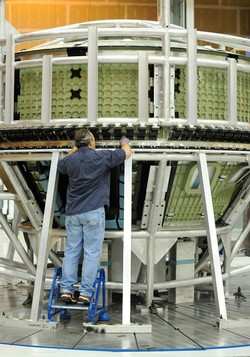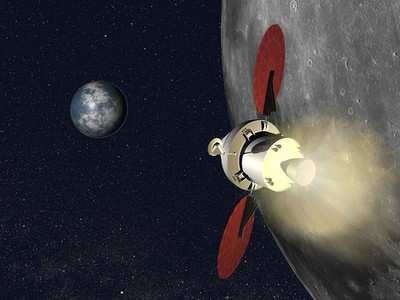Wed, Jul 07, 2010
Spacecraft Deemed To Meet Critical Human Space Flight
Requirements
 The Orion crew exploration vehicle has successfully completed
the Phase 1 Safety Review of NASA's Human Rating Requirements for
space exploration in low Earth orbit and beyond. The NASA/Lockheed
Martin Orion team earned the approval from NASA's Constellation
Safety & Engineering Review Panel (CSERP) upon completion of
the review, an essential requirement for the Orion program to move
forward to the Critical Design Review and Phase 2 Safety
Review.
The Orion crew exploration vehicle has successfully completed
the Phase 1 Safety Review of NASA's Human Rating Requirements for
space exploration in low Earth orbit and beyond. The NASA/Lockheed
Martin Orion team earned the approval from NASA's Constellation
Safety & Engineering Review Panel (CSERP) upon completion of
the review, an essential requirement for the Orion program to move
forward to the Critical Design Review and Phase 2 Safety
Review.
The safety review process is a rigorous and exhaustive look at
the design and operational concepts to assure that all requirements
have been adequately met. System safety requirements address
potentially catastrophic failures that could result in loss of crew
or loss of mission during launch, ascent to orbit, approach and
docking to the International Space Station, re-entry, landing, and
recovery operations. Thoroughly reviewing spacecraft designs and
operations for possible causes of such catastrophic failures, and
designing appropriate mitigations for them, is a critical part of
NASA's human rating program.

Orion Crew Module Under Construction
"Completing this significant safety review puts Orion well down
the road in satisfying the requirements to minimize the nation's
gap in human space flight," said Paul Benfield, Lockheed Martin
Integrated Reliability & Safety Manager for the Orion Program.
"NASA's current human rating standards include stringent
requirements and thorough procedures developed from the best
practices of NASA's past 50 years of human spaceflight."
Benfield noted that human rating a vehicle for beyond low Earth
orbit (LEO) is particularly challenging given the greater autonomy
of such a mission, the extended mission durations, and increased
time to return to Earth. This Phase 1 Safety milestone covers the
requirements for Orion missions in LEO as well as sortie missions
to the moon. The design enables a six-month on-orbit duration which
is vital to assure return capability of the space station crew, as
well as support autonomous lunar orbit operations. This long
duration design far exceeds the one- to two-week capabilities
offered by other potential providers.

Artist's Rendering
"Human rating a spacecraft is not a feature you can just simply
add on once the vehicle is designed," explained Benfield. "It is a
process that requires endurance and attention to detail to ensure
that safety is driven into every aspect of the vehicle design and
operations from the beginning. Optimal safety and reliability is
strategically and systematically incorporated into the vehicle from
day one, concurrent with critical trade decisions considering
vehicle mass and cost."
More News
Pilot Also Reported That Due To A Fuel Leak, The Auxiliary Fuel Tanks Were Not Used On June 4, 2025, at 13:41 eastern daylight time, a Piper PA-23, N2109P, was substantially damage>[...]
From 2023 (YouTube Edition): Reflections on War’s Collective Lessons and Cyclical Nature The exigencies of war ought be colorblind. Inane social-constructs the likes of racis>[...]
Pilot Reported That He Was Unfamiliar With The Single Seat Amateur-Built Airplane And His Intent Was To Perform High-Speed Taxi Testing Analysis: The pilot reported that he was unf>[...]
From 2023 (YouTube Edition): First Kits to Ship October 2023 Having formerly resurrected the storied shape of the Ryan ST—in effigy, anyway—Montrose, Colorado-based Tim>[...]
Performance-Based Navigation (PBN) [ICAO] Area navigation based on performance requirements for aircraft operating along an ATS route, on an instrument approach procedure or in a d>[...]
 NTSB Prelim: Piper PA-23
NTSB Prelim: Piper PA-23 Classic Aero-TV: One Mans Vietnam
Classic Aero-TV: One Mans Vietnam NTSB Final Report: Capella Aircraft Corp FW1C50
NTSB Final Report: Capella Aircraft Corp FW1C50 Classic Aero-TV: Timber Tiger Touts Curtiss Jenny Replicas
Classic Aero-TV: Timber Tiger Touts Curtiss Jenny Replicas ANN's Daily Aero-Term (07.04.25): Performance-Based Navigation (PBN) [ICAO]
ANN's Daily Aero-Term (07.04.25): Performance-Based Navigation (PBN) [ICAO]





